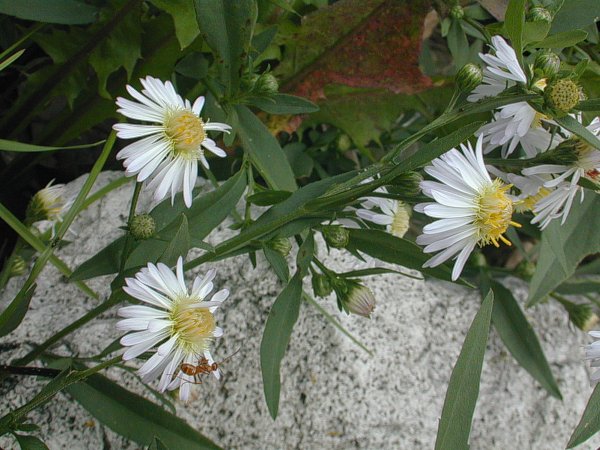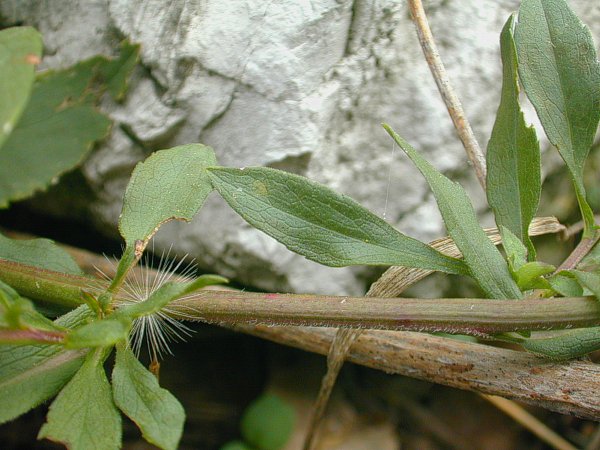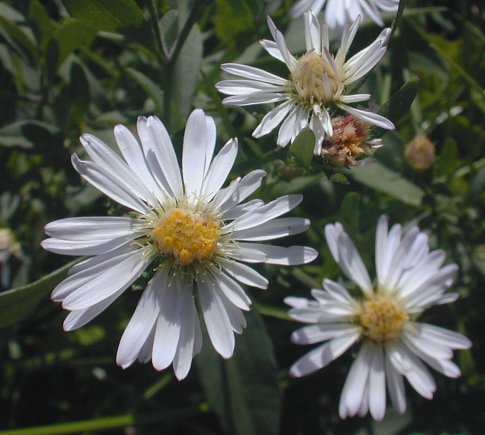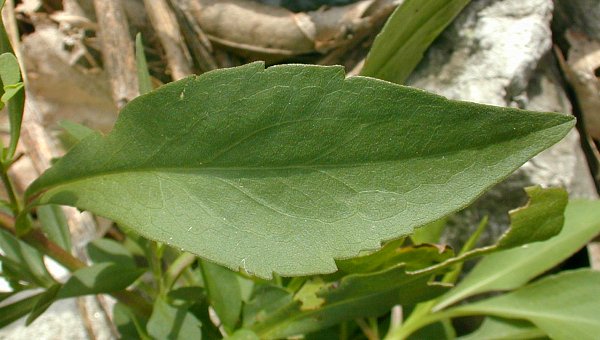Description: This perennial herbaceous plant is 1–3½' tall, branching occasionally. The central stem and lateral stems are light green to dull red, terete, and sometimes shallowly grooved; they usually have vertical lines of white hairs. Older lower stems sometimes become brownish, woody-looking, and glabrous. Alternate leaves occur along the entire length of the stems, becoming gradually smaller in size as they ascend. These leaves are up to 5" long and ¾" across; they are narrowly lanceolate, elliptic, or elliptic-rhombic in shape, while their margins are entire (toothless) or sparingly serrated. Usually the lower to middle leaves have a few teeth along their middle to outer margins, while the upper leaves are entire. The leaves taper to acute tips, while their bases are wedge-shaped (cuneate); they are either sessile or taper gradually into short winged petioles. The upper leaf surface is medium to medium-dark green and glabrous, while the lower leaf surface is slightly more pale and usually glabrous (very young leaves may be sparsely short-pubescent below). A reticulated network of secondary veins is clearly visible on the lower side of each leaf, and sometimes it is also visible on the upper side. During cold autumn weather, sometimes the foliage becomes purple. The central stem terminates in a panicle of flowerheads up to 8" long and 4" across; smaller panicles of flowerheads are often produced from upper lateral stems and the axils of upper leaves.

The branches of these panicles are similar to the stems, except they tend to be more hairy and more grooved. Solitary leafy bracts up to 1½" long and 8 mm. across occur where these branches diverge, and they also occur at the bases of peduncles (basal stalks of the flowerheads). These peduncles are up to 1½" long. Each daisy-like flowerhead spans ½–¾" across, consisting of 20-40 ray florets that surround a dense head of numerous disk florets. The petaloid rays of a flowerhead are white and linear-oblong; when a flowerhead is fully open, they are widely spreading to somewhat declined. The corollas of disk florets 3-5 mm. long, tubular in shape, and 5-lobed along their rims; they are initially yellow, but later become orange-red. The lobes of the corollas are triangular in shape and ascending to widely spreading. The ray florets are fertile and pistillate, while the disk florets are fertile and perfect. Surrounding the base of each flowerhead, there are numerous phyllaries (scale-like floral bracts) in several series that are erect to ascending. The phyllaries are 2-4 mm. long, light to medium green, linear-oblong in shape, and glabrous. The blooming period occurs from late summer into autumn for 1-2 months. Afterwards, the florets are replaced by achenes with small tufts of white hair; they are dispersed by the wind. The achenes are about 1.5–2 mm. long, gray to dark gray, narrowly oblanceoloid in shape, slightly flattened, and finely pubescent. The root system is fibrous and long-rhizomatous. Clonal colonies of plants are often produced from the rhizomes.

Cultivation:
The preference is full to partial sun and moist conditions. Favored
locations are poorly drained areas that form pools of water
temporarily, but later dry out. This plant can tolerate average levels
of moisture and some drought, but it won't grow as large and its lower
leaves may shrivel away. The soil can contain loam, clay, gravel, or
even large rocks – this plant doesn't seem to care. Some foliar disease
may occur, such as patches of rust or powdery mildew, but the foliage
is usually in good shape during the blooming period of autumn. In damp
open areas, this plant may spread aggressively by means of its rhizomes.
Range & Habitat:
The native Panicled Aster occurs in most counties of Illinois (see Distribution
Map),
where it is common. Habitats include disturbed areas of moist prairies,
prairie swales, openings and edges of floodplain woodlands, moist
meadows along rivers, thickets, gravelly seeps, low areas along ponds
and small lakes, edges of marshes, seasonal wetlands, roadside ditches,
poorly drained gravelly areas of junkyards, fence rows, pastures, and
abandoned fields. This plant often thrives in moist disturbed areas
that are subjected to little or no mowing.

Faunal Associations: The nectar and pollen of the flowerheads attract many kinds of insects, including honeybees, bumblebees, leaf-cutting bees (Megachile spp.), Halictid bees (including green metallic bees), Halictid cuckoo bees (Sphecodes spp.), oligolectic Andrenid bees (Andrena spp.), Crabonid wasps (Ectemnius spp. & others), bee wolves (Philanthus spp.), thread-waisted wasps (Ammophila spp.), paper wasps (Polistes spp.), Eumenine wasps, Ichneumonid wasps, Syrphid flies, bee flies (Bombyliidae), Tachinid flies, flesh flies (Helicobia spp. & others), bottle flies (Lucilia spp.), Muscid flies, butterflies (Vanessa spp. & others), skippers, and beetles. Other insects feed destructively on the leaves and other parts of the Panicled Aster (Aster lanceolatus). These species include the leaf beetles Microrhopala xerene, Ophraella pilosa, Paria thoracia, and Sumitrosis inaequalis; larvae of the leaf-mining flies Nemorimyza posticata, Ophiomyia texana, and Phytomyza albiceps; larvae of Asteromyia laeviana (Papery Blister-Gall Midge) and the gall fly Rhopalomyia asteriflorae; the aphid Uroleucon olivei; and caterpillars of a butterfly, Phyciodes tharos (Pearl Crescent); see Clark et al. (2004), Needham et al. (1928), Felt (1917), Blackman & Eastop (2013), and Opler & Krizek (1984). Other insects that feed on this aster and other asters (Symphyotrichum spp.) include the larvae of fruit flies, plant bugs, several aphids, grasshoppers, and the larvae of many moths. Vertebrate animals also use asters as a source of food. The Ruffed Grouse and Wild Turkey feed on the seeds and foliage of these plants, while the Tree Sparrow and White-footed Mouse feed on the seeds only. Mammalian herbivores also browse on the foliage of asters, including deer, rabbits, groundhogs, horses, cattle, and sheep. In particular, White-Tailed Deer are very fond of the foliage of Panicled Aster, browsing its leafy stems to within inches of the ground (Martin et al., 1951/1961; personal observations).

Photographic
Location:
The photographs were taken at a rock-filled ditch near Urbana, Illinois.
Comments:
Panicled Aster (Symphyotrichum
lanceolatum) is rather showy when it is in bloom,
even though it is often treated as an undesirable weed. This aster can
be difficult to distinguish from other asters (Symphyotrichum spp.)
that have small flowerheads
with white petaloid rays. It has several characteristics that, when
they are taken together, are useful in making a correct identification:
1) its flowerheads are usually ½" across or slightly more, 2) its
flowerheads have at least 20 ray florets, 3) its leaves have
wedged-shaped bases, rather than rounded or cordate
(heart-shaped), 4) its mature leaves are hairless on both their
upper and lower sides, 5) its stems usually have lines of fine
white hairs, and 6) its panicles of flowerheads have conspicuous leafy
bracts. Regarding nomenclature, alternative common names for this
plant are 'Tall White Aster' and 'White Field Aster,' while older
scientific names include Aster
lanceolatus, Aster paniculatus
and Aster simplex.